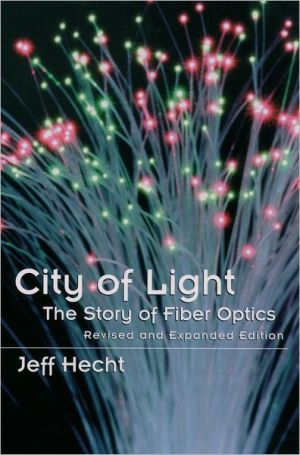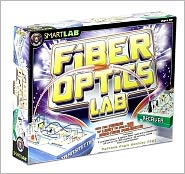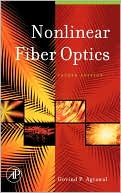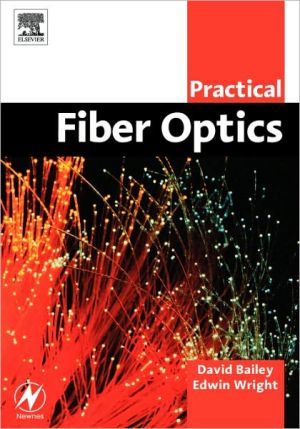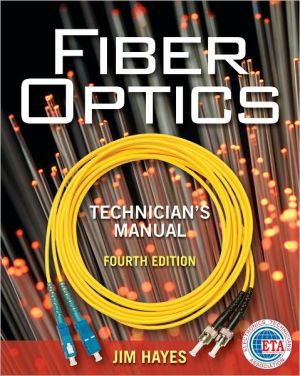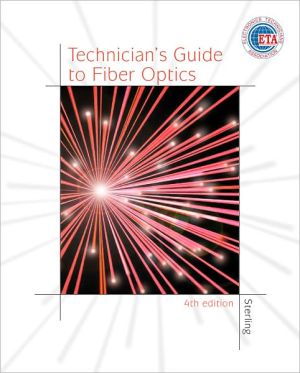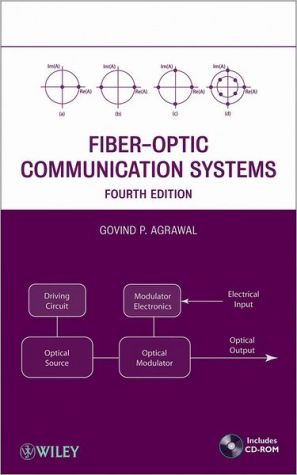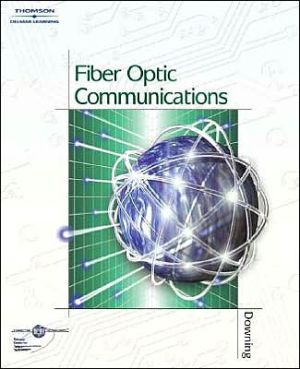City of Light: The Story of Fiber Optics
City of Light tells the story of fiber optics, tracing its transformation from 19th-century parlor trick into the foundation of our global communications network. Written for a broad audience by a journalist who has covered the field for twenty years, the book is a lively account of both the people and the ideas behind this revolutionary technology.\ The basic concept underlying fiber optics was first explored in the 1840s when researchers used jets of water to guide light in laboratory...
Search in google:
This paperback edition of a work first published by Oxford in 1999 has a new final chapter, on the second phase in fiber- optics, when stock in bandwith technology became overvalued and went bust in the late 1990s. The book is valuable for its clear descriptions of the technology while also tracing the careers and development of the people and companies that made this a dominant industry. Hecht, an engineer, writes on science and technology in the UK. Annotation © 2004 Book News, Inc., Portland, OR Publishers Weekly The first underwater telegraph cable was laid between England and the Continent in 1850, with the cable from America to Europe following in 1858. But for the next century, improvements in transcontinental communication came slowly. By the 1940s, Americans could talk to Europeans via a static-plagued radiophone. By the early 1980s, satellite transmissions had improved conversation clarity significantly, but callers were still annoyed by delay and feedback. Those who have made a transcontinental call recently, however, know that the wonders of fiber optics have made it possible to hear a pin drop on the Champs-Elysees. In this deft history, Hecht, a writer for the British weekly New Scientist, shows how the illuminated fountains that thrilled crowds at the great 19th-century exhibitions convinced scientists that light can be guided along narrow tubes. In our century, scientists used these tubes of light first to look inside the human body and then, as the physics of wave transmission were better understood, to transmit audio and optical information. Hecht explains which technological advances have made fiber optics the backbone of our telephone system in the last 10-15 years and how everyday applications should increase exponentially once fibers are connected directly to our homes. Already optical fibers are used in many surprising ways: guiding laser light in life-saving surgery; embedded in concrete to monitor stress in bridges; wound into gyroscopes to improve airline safety. Hecht's latter chapters are bogged down slightly with details that will mainly interest readers working in related areas, but general science buffs should enjoy his account of the development of the technology that will change our lives in many unexpected ways in the next quarter century. (Feb.)
\ \ \ \ \ Chapter One\ Introduction\ \ \ Building a City of Light\ \ \ I ... managed to illuminate the interior of a stream [of water] in a dark space. I have discovered that this arrangement ... offers in its results one of the most beautiful, and most curious, experiments that one can perform in a course on optics\ —J. Daniel Colladon, 1842\ \ \ The Sunday evening phone call sounded completely ordinary. A friend who lives a few miles away wanted me to call a few other Caltech graduates for the alumni association. I had helped him before, and I agreed to help him again. We chatted a bit, and as we finished, he added, "You know how dedicated I am? I'm calling from my hotel room in Cairo at two in the morning."\ I was stunned. When I was growing up in the 1950s and 1960s, it was rare to get long-distance calls from relatives a few hundred miles away. They didn't call to chat but to report news in static-toned voices that sounded far, far away. My friend's voice sounded as clear and sharp as a telephone can be, as if he was calling from his home in the next town, not 5400 miles away in Egypt. Such miracles are the daily work of fiber optics.\ \ \ A Global Fiber-Optic Network\ \ \ I have grown accustomed to such miracles. As a correspondent for the London-based weekly magazine New Scientist, I use the telephone network to reach across the world. International dialing is easy. My fingers have memorized the codes for the London office. I start with 011, the code for international directcalling. Then comes 44, the country code for the United Kingdom, and 171, the city code for central London. Those eight digits route the call to the right region; four digits—a "1" and the area code—suffice for calls in North America. Then I push seven more buttons and after a breath or two a phone rings on an editor's desk.\ You cannot mistake a telephone voice for a live one; the telephone is not a high-fidelity instrument. Some distort voices much more than others. With a little practice, you can recognize speaker phones, cellular phones, or $9.95 discount-store specials. Yet without the effects of the telephone itself, it is hard to tell a call from London from one from down the block. I can recognize the editors' voices; they can tell when sinus trouble clogs my nose, or laryngitis roughens my throat. The telephone lines are as transparent as they sound. A few miles from my home, my telephone calls shift from copper wires to glass optical fibers.\ The part of the telephone network we see is electrical. A microphone converts the vibrations of air molecules shaken by my voice into electronic signals. The phone sends the electronic signals through copper wires in my house, which connect to wires that run to a telephone pole across the street. From there, more wires carry the signals down the pole and through underground ducts to a building a few miles away, where electronics convert them to digital code—a string of ones and zeroes. The circuits decode the numbers I dialed, figure out the call's destination, switch the signals to a cable headed in that direction, and shuffle the bits of my voice together with the digitized signals from other phone calls being sent along the same digital highway on their routes to their separate destinations.\ The electronic bit stream switches off and on a tiny semiconductor laser no larger than a grain of salt, turning my voice into pulses of invisible infrared light. A hair-thin optical fiber collects the millions of pulses a second that carry my words—and other voices and facsimile messages and computer data—and sends them on their way south to New Jersey, where domestic phone lines connect to fiber-optic cables that cross the Atlantic. At the international switching center, other circuits amplify and reroute the bits of my voice along with thousands of other digitized conversations. Then they travel thousands of miles through optical fibers protected from the abyssal depths by the layers of white plastic and metal shielding that make up a 0.827-inch (21-millimeter) submarine cable. On the other side of the Atlantic, a British international switching center reroutes them to other fibers that carry them to London. In the British capital, more fiber-optic cables carry the light pulses through a maze of underground ducts to the building that houses New Scientist. An electronic receiver in a box somewhere in the building turns the light pulses back into electrical signals that go through wires to the phones on the editors' desks.\ We don't see the optical fibers in the telephone system, any more than we see the electronic chips that control a videotape recorder. If we were to see them, they would not look spectacular. A single optical fiber is a tiny clear filament, coated with plastic that makes it a little thicker and stiffer than a human hair, like monofilament fishing line. Your eye can easily miss a single bare fiber, and your fingers fumble at trying to pick one up. The semiconductor lasers that generate the signals that pass through the fibers resemble tiny flakes of metallic confetti, the size of grains of salt.\ Yet these technological wonders are far more sophisticated than they look. The fibers that span the globe are the clearest, purest glass. Ordinary plate glass is very different stuff, old-fashioned pea-soup London smog compared to the sharp, clear mountaintop air of fibers. A pane of plate glass transmits only about 90 percent of the light that reaches it, no matter how clean you scrub it. The surfaces reflect most of the remaining 10 percent, but the glass itself absorbs some. We are so used to the reflections and dirt that we use them as cues to tell if the glass is there; clean a glass door too well, and someone may try to walk through it. We often don't notice that any light is lost inside the glass. Yet look into the edge of a piece of plate glass and it seems dark and green, because little light can pass through the several inches of glass between the edges of the pane.\ Plate glass is good enough for windows. Binocular and camera lenses are made of more costly optical glasses that contain fewer light-absorbing impurities. The glass for optical fibers must be even purer—with no more than ten impurities per billion atoms. The fibers are as clear as glass can be, so clear that even after passing through 100 kilometers (60 miles) of fiber, one percent of the light emerges from the other end. It's as if you could duck your head into the water below the cliffs of Dover and peer through the English Channel to dimly see the feet of bathers wading along the French beach at Calais.\ The tiny lasers that send the signals are not simple crystals like grains of salt. They are made of thin layers of semiconductor, with compositions designed to control how light and electric current flow through them. Their structures are delicate and elaborate; the layers are thinner than a thousandth of a millimeter, or 1/25,000th of an inch. The tiny chips are cheap, but it is expensive to package them to direct their light unerringly into the tiny cores that carry light in optical fibers.\ \ \ Watching the Breakthrough\ \ \ Optical fibers didn't seem likely to go so far when I first encountered them a quarter century ago. They seemed mere optical toys, which guided light along their lengths. Bend a fiber, and the light turns the corner. Hold one end of a bundle of fibers close to a light bulb and let the other end splay out, and the tips of the fibers sparkle with light as a decorative lamp. Back then, I bought my sister one as a Christmas present. She used it for a couple of years, but it ended up as a techno-artifact in my attic.\ I started hearing about fiber optic communications a couple of years late in 1974, when I started working at a little laser-industry magazine called Laser Focus. It was one of dozens of new ideas the industry was investigating, and it didn't even seem the most promising at the time. Lots of people tested lasers for various applications, but few of the ideas proved practical.\ The editor wanted me to chase news, so I called around America, asking California companies and Bell Labs in New Jersey about fiber-optic communications. However, I didn't call overseas when I heard that a British police department had installed the first practical fiber-optic communication system in 1975. I didn't have a phone number, and I knew international calls were expensive. A few years earlier a cousin stationed in South Korea by the Army had made a collect call to a girl friend in New York. They argued, and spent about a half hour on the line—and ran up a bill of $750. That was about three weeks of my salary, and I knew better than to run up bills like that. I based my story on a report in another magazine; it wasn't good journalism, but I had to fill the magazine.\ Progress over the next few years was rapid. In 1976, Bell Labs ran a field trial in Atlanta. The next year, Bell Labs, GTE, and British Telecom used fiber optics to carry live telephone traffic in their networks. They poked and prodded and cautiously examined the new technology, as if they expected a horde of gremlins to emerge and shout "gotcha," and all the potential attractions of fiber optics to evaporate. Again and again they reported the same welcome but monotonous litany—the system worked as promised.\ There are few more exhilarating experiences in journalism than riding the crest of a technology breakthrough. Everywhere I turned there were advances. Fibers improved, lasers improved, detectors improved. Each new system sent signals faster and farther than old ones. New people and companies came into the field. The little village of fiber-optic pioneers grew. I was caught up in the excitement of a fast-growing field. I still remember the thrill of hearing Peter Runge of Bell Labs outline plans for laying the first transatlantic fiber-optic cable at a 1980 meeting. I felt the same thrill I remembered as a boy reading Werner Van Braun's plans for space travel in Across the Space Frontier. Fiber-optic communications was on a roll.\ Laser Focus had grown, too, and after seven years I was managing editor with four people working for me, but it wasn't where I wanted to be. I left to freelance and naturally started writing about fiber optics. I wrote an article on the fiber-optics market for a short-lived magazine called Technology, and one about futuristic fiber communications to the home for Omni. Meanwhile, the technology grew apace. I watched three generations of fiber-optic systems appear in five years. Laboratory systems kept pushing to higher and higher performance. Optical fibers became the medium of choice for long-distance telephone transmission, the backbone of national networks. The first transatlantic fiber cable, called TAT-8, came into service at the end of 1988. Naturally, I wrote about it for New Scientist.\ I also noticed the difference it made in international calls. Before TAT-8, satellite links carried most calls. The signals took a fraction of a second to make the round trip to and from the satellite, parked 22,000 miles above the equator, just long enough to disturb the timing of a conversation. Satellite channels sometimes brought other irritations. I recall many one-way conversations, when London could hear me but I couldn't hear them, or vice versa. Sometimes silence, or a hum or whine from presumably unhappy electronics, suddenly replaced the British voices. Other times echoes of my words would return a second after I spoke them, often louder than the voice on the other end. "Sorry," I would say, "let's try again," and one of us would call back to try to get a better line.\ The fiber cable gave a new alternative. The bad lines and the satellites were still there, but TAT-8 added 40,000 good circuits through echo-free cable—a thousand times more than the first transatlantic telephone cable carried in 1956. Since then, more fiber cables have crossed the Atlantic, and poor connections to Britain are as rare as within North America. Even Egypt, Israel, Hong Kong, and Australia come in loud and clear. When something goes wrong with the phone line, it's almost always in the few miles of aged copper wire that connect my house to the nearest fibers in the telephone network.\ Wires, cables, fibers, and other transmission media are not the whole story of the revolution in communications. Telephone calls must be routed from point to point, by switches that make temporary connections in the global lattice of fibers, wires, and radio signals. At the start of the century, telephone switching was by hand, with ranks of operators plugging wires into sockets in the sort of big black switchboards that survive only in old movies. Later clattering banks of electromechanical switches replaced them, which flipped, flopped, and stepped from point to point, making and breaking connections in response to control pulses that originated in telephone dials. Sometimes you could hear the mechanical switches clicking on their way to making connections on the line, just as you could hear the pulses as a telephone dial rotated. Later came transistorized electronic switches, special-purpose computers designed to send signals along complex routes. Without them, phone calls could never weave their ways through the maze of big-city networks. But they're another story, to be told another day.\ \ \ How Fiber Optics Changed Communications\ \ \ What is so good about fiber optics? Looking at the telephone network will help you understand. The old wires running to my house are both its strength and weakness—new equipment has to work with the same wires used for decades. With a screwdriver and very little ingenuity, I can hook up a massive 45-year-old dial phone in Western Electric basic black. Someone dropped it a few years back and broke a corner off the case, but it still works. So do my modem, answering machine, and fax machine. It's a simple, versatile system of information pipes that is standard throughout North America.\ Phone companies laid the wires to provide what they call "POTS," plain old telephone service. They designed the network to carry electrical signals that replicate sound waves at the frequencies we must hear to understand speech—300 to 3000 hertz (or cycles per second), if you like specifications. That's only part of the human ear's nominal range of 20 to 20,000 hertz, so sound quality isn't good. But it does the job because you don't need high fidelity to understand speech.\ Phone wires can carry other audio signals as well as speech. The push buttons on a Touch-Tone phone whistle musical notes at audio frequencies. Modems and fax machines warble their codes as tones in the audible speech range. Our ears don't understand their electronic speech, but the telephone network carries their signals nonetheless, and other modems and fax machines decode the sounds.\ The phone wires in your walls are strands of copper, coated with plastic insulator and grouped in pairs (or sometimes fours). When they have to go a long way, they're often wound around each other, making what the phone industry calls twisted pairs. The problem with standard twisted-pair phone wires is that they were designed to carry a single conversation, which doesn't amount to much information. Adjust and condition them properly, and if all goes well they can carry the equivalent of a few dozen conversations a few miles, or of many more over a thousand feet. But that's it. So far, no more information can fit through the pipe.\ Modern telephone systems contain electronics that convert the whistles, warbles, and words into digital signals within a few miles of your home. Each "voice channel" becomes a series of 56,000 bits per second. More electronics interleave those bits with the bits that encode dozens, hundreds, or even thousands of other telephone calls. Phone companies have a hierarchy of levels, each one combining more digitized voice channels to generate a higher-speed signal. Sometimes the slower signals go through special metal cables or are relayed by microwave towers, but typically they go through optical fibers.\ Most modern fibers concentrate light signals in tiny cores about nine micrometers—0.009 millimeter—across. That might seem a tiny pipe, but in fact it has a huge information capacity. Its small size keeps short pulses of light from spreading out and interfering with each other as they travel down the fiber. With the best state-of-the-art transmitters phone companies can buy, a single fiber can carry up to 400 billion bits per second, equivalent to five million telephone conversations. Pairs of fibers carry two-way traffic, one carrying signals in each direction.\ The clarity of glass fibers is another advantage. Depending on the design, they can carry signals tens of miles without any internal amplification. That's vital if you're building a cable crossing a continent or an ocean, or a cable-television network serving a small city. Cable television network use coaxial cable ("coax"), with a central wire surrounded by a plastic layer that is encased in a metal sheath, and usually covered with a protective jacket. Coax thinner than a pencil hooks home video systems together; thicker coax—costlier but able to carry signals farther—links cable companies to homes. Yet even those costly coaxial cables can't carry signals very far. Cable companies have to install signal-amplifying repeaters about every half kilometer (500 yards) because the signal weakens with distance. Those amplifiers keep cable technicians busy. You don't need them with fiber, so cable-television companies are replacing their old coax with fiber-optic cables.\ The huge information capacity of optical fibers changes the ground rules of telecommunications, which the telephone defined early in the twentieth century. What seemed adequate pipeline then today delivers only an electronic trickle in a world parched for information. The telephone network was engineered to manage information as carefully as nomads husband the scarce waters of the Sahara. The huge capacity of fibers promises to irrigate our dry lands, but first we must find uses for the flow that will justify the costs of extending the data pipeline all the way to our homes. We value information almost instinctively, like desert nomads think water is a "good thing," but faced with an overwhelming abundance, we are as lost as a Bedouin by the sea. We have long dreamt of making the desert bloom, but we don't know how.\ \ \ The Roots of Fiber Optics\ \ \ I discovered fiber-optic communications when the technology was still young and the City of Light was but a small town. Some early settlers are still around, active developers of new technology or elder statesmen. Others have died or moved on. As the field has grown, many new people have joined it. Awareness of fiber optics has spread around the world like the glass threads themselves. The field and the technology have not stopped growing. Even as I put the finishing touches on this book, I heard of new advances that promise even better fiber-optic systems in coming years.\ Where did this technological revolution come from? How did it grow so fast, out-competing older and better-funded projects? This book tells the story, one more fascinating than I imagined when I started.\ In studying fiber optics, I have learned how technology evolves, like life itself. The idea began as little more than a parlor trick, guiding light in jets of water or bent glass rods to make physics lectures more entertaining. Brighter electric lights powered illuminated fountains that awed visitors to the great Victorian exhibitions, who were accustomed to faint gas lights. Later, bent rods of glass or plastic guided light to illuminate teeth for dental exams.\ Another generation of engineers adapted light guiding, assembling arrays of thin, flexible glass fibers to look into inaccessible places. The market niche was not filled until developers found how to keep light from leaking between fibers. Once that innovation was perfected, the technology of fiber bundles evolved rapidly, like animals that had just arrived in a new, unpopulated land. New applications proliferated in the late 1950s and 1960s, from looking down the throat to military imaging systems.\ Flexible bundles of optical fibers let physicians reach into otherwise inaccessible parts of the body. Surgeons threaded fiber-optic endoscopes down patients' throats to examine the interiors of their stomachs without surgery. Similar instruments probed the other way through the intestines, seeking cancers or precancerous lesions so physicians could remove them before they spread. "Fiber optics saved my life," a geologist told me, by allowing his surgeon to direct radiation therapy precisely at a tumor inside his skull.\ Optical communications required different types of optical fibers, and the evolutionary leap was not easy. Some people who have worked in both areas consider medical imaging bundles a different technology than communication fibers. It took breakthroughs in transmission concepts and glass production, and like the first dinosaurs to take wing as birds, the flight of fiber-optic communications was at first uncertain. But the evolutionary potential was there, and an outpouring of innovations launched fiber communications so it soared high.\ \ \ Why a "City of Light"?\ \ \ The title "City of Light" first came to mind as a catchy phrase. The more I worked on the book, the more I liked it.\ One reason is that the roots of fiber optics lie in the nineteenth century, a time when scientists entertained the public by devising elegant lecture demonstrations. First they guided light along jets of water in lecture halls. Later engineers picked the same principle to show glittering displays of light in the night-time "fairy fountains" of the great Victorian exhibitions. The most spectacular was in Paris, the City of Light, in 1889.\ Another is that a veritable city of people helped create fiber-optic technology, with their work spanning decades. Too often we gloss over the many people behind some great innovation, to focus on a single "inventor." Look at the wall of inventions at the subway stop serving the Massachusetts Institute of Technology, and you will be told that Narinder Kapany invented fiber optics in 1955. In reality, Kapany was only one of many contributors, and 1955 marks only the awarding of his doctoral degree for a project conceived by his thesis adviser, Harold H. Hopkins. The technology grew from the interplay of many people and many ideas, often competing with each other. I have tried to focus on the most important, but there is no room in a book like this to credit everyone.\ In addition, the best-known role of fiber optics has become as a technology of communication, and communication is an essential part of any city. Both communication and the failure to communicate play important roles in the story. And this is a story played out on a grand scale, in laboratories around the world. Most of the work was done in Europe, North America, and Japan, but some developers came from other places, including China, India, and South Africa. The fruits of their labor now link all the continents except Antarctica. We can explore the world through optical fibers, and talk with people half a world away. That still amazes me when I stop to think about it.\ Finally, the idea of a City of Light looks toward the future that we hope can in some way be brighter. The fiber-optic revolution is not over. New wonders continue emerging from the labs, and skilled engineers keep converting them into practical hardware. A quarter century has passed since the first visionary suggested stringing fiber optics all the way to homes, and they haven't arrived at my door yet. Perhaps I have become too much a fan of fiber optics, but I still think that day should come before another quarter century passes.
Preface to the Sloan Technology SeriesAuthor's Preface1Introduction: Building a City of Light32Guiding Light and Luminous Fountains (1841-1890)123Fibers of Glass284The Quest for Remote Viewing: Television and the Legacy of Sword Swallowers (1895-1940)345A Critical Insight: The Birth of the Clad Optical Fiber (1950-1955)46699 Percent Perspiration: The Birth of an Industry (1954-1960)607A Vision of the Future: Communicating with Light (1880-1960)768The Laser Stimulates the Emission of New Ideas (1960-1969)929"The Only Thing Left Is Optical Fibers" (1960-1969)10310Trying to Sell a Dream (1965-1970)11711Breakthrough: The Clearest Glass in the World (1966-1972)13112Recipes for Grains of Salt: The Semiconductor Laser (1962-1977)14713A Demonstration for the Queen (1970-1975)16014Three Generations in Five Years (1975-1983)17615Submarine Cables: Covering the Ocean Floor with Glass (1970-1995)20116The Last Mile: An Elusive Vision21617Reflections on the City of Light227App. ADramatis Personae: Cast of Characters239App. BA Fiber-Optic Chronology247Notes259Index305
\ Publishers Weekly\ - Publisher's Weekly\ The first underwater telegraph cable was laid between England and the Continent in 1850, with the cable from America to Europe following in 1858. But for the next century, improvements in transcontinental communication came slowly. By the 1940s, Americans could talk to Europeans via a static-plagued radiophone. By the early 1980s, satellite transmissions had improved conversation clarity significantly, but callers were still annoyed by delay and feedback. Those who have made a transcontinental call recently, however, know that the wonders of fiber optics have made it possible to hear a pin drop on the Champs-Elysees. In this deft history, Hecht, a writer for the British weekly New Scientist, shows how the illuminated fountains that thrilled crowds at the great 19th-century exhibitions convinced scientists that light can be guided along narrow tubes. In our century, scientists used these tubes of light first to look inside the human body and then, as the physics of wave transmission were better understood, to transmit audio and optical information. Hecht explains which technological advances have made fiber optics the backbone of our telephone system in the last 10-15 years and how everyday applications should increase exponentially once fibers are connected directly to our homes. Already optical fibers are used in many surprising ways: guiding laser light in life-saving surgery; embedded in concrete to monitor stress in bridges; wound into gyroscopes to improve airline safety. Hecht's latter chapters are bogged down slightly with details that will mainly interest readers working in related areas, but general science buffs should enjoy his account of the development of the technology that will change our lives in many unexpected ways in the next quarter century. (Feb.)\ \ \ \ \ Library JournalAn engineer by training, New Scientist correspondent Hecht explores the history of fiber optics in this interesting and far-reaching study. Beginning in Victorian Europe, his chronology traces the complex but fascinating drama of one of the key elements in today's global telecommunications explosion. Critical attention is given to the diverse group of participants actively working on fiber optics over the past 150 years, revealing the sometimes fortuitous steps to scientific discovery. This readable, well-documented, and scholarly text includes an informative glossary of names and a concise reference to fiber-optic development. Highly recommended for all public and academic libraries.--Dayne Sherman, Southeastern Louisiana Univ., Hammond\ \
